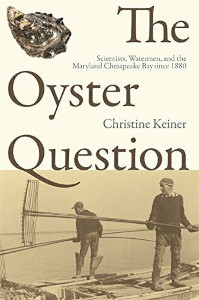
The Chesapeake Bay is the largest estuary in the United States. The Bay is located in the Mid-Atlantic region and is primarily separated from the Atlantic Ocean by the Delmarva Peninsula, including parts of the Eastern Shore of Maryland, the Eastern Shore of Virginia, and the state of Delaware. The mouth of the Bay at its southern point is located between Cape Henry and Cape Charles. With its northern portion in Maryland and the southern part in Virginia, the Chesapeake Bay is a very important feature for the ecology and economy of those two states, as well as others surrounding within its watershed. More than 150 major rivers and streams flow into the Bay's 64,299-square-mile (166,534 km2) drainage basin, which covers parts of six states, New York, Pennsylvania, Delaware, Maryland, Virginia, and West Virginia, and all of Washington, D.C.

Catonsville is a census-designated place (CDP) in Baltimore County, Maryland. The population was 44,701 at the 2020 US Census. The community is a streetcar suburb of Baltimore along the city's western border. The town is known for its proximity to the Patapsco River and Patapsco Valley State Park, making it a regional mountain biking hub. The town is also notable as a local hotbed of music, earning it the official nickname of "Music City, Maryland." Catonsville contains the majority of the University of Maryland, Baltimore County (UMBC), a major public research university with close to 14,000 students.

Smith Island is a collection of three distinct island communities – Tylerton, Rhodes Point, and Ewell, Maryland – on the Chesapeake Bay, on the border of Maryland and Virginia territorial waters in the United States. The island is the last inhabited island in Maryland that is not accessible by vehicle. Most of the islands are eroding due to tidal currents and sea level rise; a study conducted in 2008 by the DNR reported that Smith Island is expected to completely erode by 2100 if no action is taken.

Oyster is the common name for a number of different families of salt-water bivalve molluscs that live in marine or brackish habitats. In some species, the valves are highly calcified, and many are somewhat irregular in shape. Many, but not all oysters, are in the superfamily Ostreoidea.
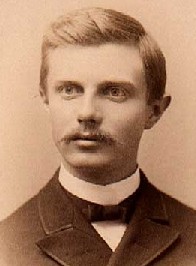
Frederick Jackson Turner was an American historian during the early 20th century, based at the University of Wisconsin-Madison until 1910, and then Harvard University. He was known primarily for his frontier thesis. He trained many PhDs who went on to become well-known historians. He promoted interdisciplinary and quantitative methods, often with an emphasis on the Midwestern United States.

The Patuxent River is a tributary of the Chesapeake Bay in the state of Maryland. There are three main river drainages for central Maryland: the Potomac River to the west passing through Washington, D.C., the Patapsco River to the northeast passing through Baltimore, and the Patuxent River between the two. The 908-square-mile (2,352 km2) Patuxent watershed had a rapidly growing population of 590,769 in 2000. It is the largest and longest river entirely within Maryland, and its watershed is the largest completely within the state.

The eastern oyster —also called the Atlantic oyster, American oyster, or East Coast oyster—is a species of true oyster native to eastern North and South America. Other names in local or culinary use include the Wellfleet oyster, Virginia oyster, Malpeque oyster, Blue Pointoyster, Chesapeake Bay oyster, and Apalachicola oyster. C. virginica ranges from northern New Brunswick south through parts of the West Indies to Venezuela. It is farmed in all of the Maritime provinces of Canada and all Eastern Seaboard and Gulf states of the United States, as well as Puget Sound, Washington, where it is known as the Totten Inlet Virginica. It was introduced to the Hawaiian Islands in the 19th century and is common in Pearl Harbor.

Environmental history is the study of human interaction with the natural world over time, emphasising the active role nature plays in influencing human affairs and vice versa.

William Keith Brooks was an American zoologist, born in Cleveland, Ohio, March 25, 1848. Brooks studied embryological development in invertebrates and founded a marine biological laboratory where he and others studied heredity. His best known book, The Oyster, was first published in 1891 and has been reprinted many times.

Oyster farming is an aquaculture practice in which oysters are bred and raised mainly for their pearls, shells and inner organ tissue, which is eaten. Oyster farming was practiced by the ancient Romans as early as the 1st century BC on the Italian peninsula and later in Britain for export to Rome. The French oyster industry has relied on aquacultured oysters since the late 18th century.
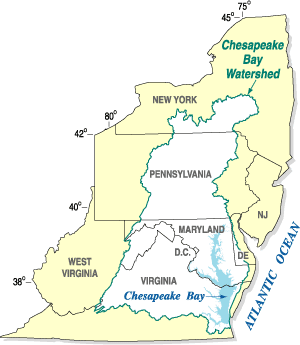
The Chesapeake Bay Program is the regional partnership that directs and conducts the restoration of the Chesapeake Bay in the United States. As a partnership, the Chesapeake Bay Program brings together members of various state, federal, academic and local watershed organizations to build and adopt policies that support Chesapeake Bay restoration. By combining the resources and unique strengths of each individual organization, the Chesapeake Bay Program is able to follow a unified plan for restoration. The program office is located in Annapolis, Maryland.
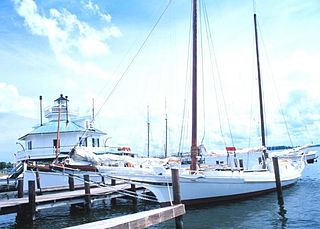
The bugeye is a type of sailboat developed in the Chesapeake Bay for oyster dredging. The predecessor of the skipjack, it was superseded by the latter as oyster harvests dropped.

Holland Island was a marshy, rapidly eroding island in the Chesapeake Bay, in Dorchester County, Maryland, west of Salisbury. The island was once inhabited by watermen and farmers but has since been abandoned due to sinking of the land's surface associated with isostatic subsidence and sea level rise. It is located in the Holland Strait, between Bloodsworth Island and Smith Island, six miles west of Wenona, Maryland and Southeast of another former island, Long Island.
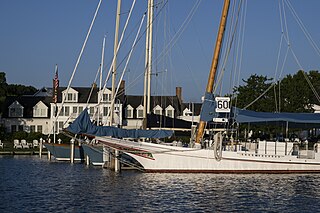
The Stanley Norman is a Chesapeake Bay skipjack, built in 1902 by Otis Lloyd, Salisbury, Maryland. She is a 48-foot-3-inch-long (14.71 m) in Length overall with length on deck (LOD) OF 47.5-foot-long (14.5 m) two-sail bateau, or "V"-bottomed deadrise type of centerboard sloop. She has a beam of 16 feet (4.9 m), a depth of 4 feet (1.2 m) at the stern with the centerboard up, and a registered tonnage of 7 tons.
Frolic was a Maryland State Oyster Police Force schooner, part of the force established to enforce state conservation laws designed to protect Maryland's oyster resources when out of state, often New England, dredgers began destroying reefs in the Chesapeake Bay. Later local opposition to licenses turned to open "warfare" in the "oyster wars" when a fleet of state vessels fought "oyster pirates" in armed conflicts. Frolic was built in 1884. The schooner was assigned to Queen Anne's County, Maryland in 1902 and later to the Commission's Second District which included Eastern Bay, and the Miles and Wye Rivers.

Reginald Van Trump Truitt was an American zoologist, Army officer, and college lacrosse player and coach. He spent his professional career studying the oyster habitat in the Chesapeake Bay. Truitt founded the Chesapeake Biological Laboratory at what is now the University of Maryland Center for Environmental Science. He also served as the first head lacrosse coach at his alma mater, the University of Maryland from 1919 to 1927. Truitt was inducted into the National Lacrosse Hall of Fame in 1959.
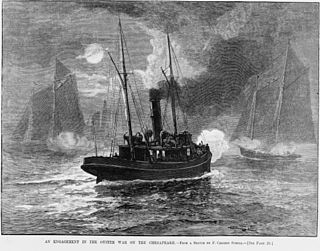
The Oyster Wars were a series of sometimes violent disputes between oyster pirates and authorities and legal watermen from Maryland and Virginia in the waters of the Chesapeake Bay and the Potomac River from 1865 until about 1959.
Markley Gordon Wolman was an American geographer, son of Abel Wolman. He was born in Baltimore, Maryland. He attended Haverford College before being drafted into the U.S. Navy during World War II. After the war, he returned to Baltimore and graduated from the Johns Hopkins University in 1949 with a degree in Geography. He earned a doctorate in Geology from Harvard University in 1953.
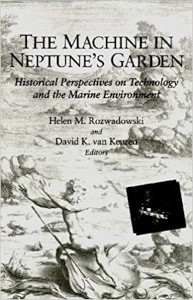
The Machine in Neptune's Garden: Historical Perspectives on Technology and the Marine Environment is a 2004 book edited by Helen M. Rozwadowski and David K. van Keuren. The book takes its name from Leo Marx's influential book The Machine in the Garden. It is a product of the Maury III conference on the history of oceanography held in Monterey, California in 2001. It argues the centrality of technology to the acquisition of knowledge of the oceans and contains ten thematically linked essays on the indispensable role of technology in the history of ocean science. It "demonstrate[s] that historians of science and technology should pay more attention to the history and historiography of oceanography." It is the most prominent work combining the history of technology, environmental history, and history of ocean sciences, and it is considered a foundational work in history of technology of the oceans and in the history of the marine environment.
The Oyster Recovery Partnership (ORP) is a 501(c)(3) nonprofit organization that leads conservation efforts of the native Eastern oyster, Crassostrea virginica, in the Chesapeake Bay and Eastern United States. The organization's activities and programs include oyster restoration, shell recycling conservation, and sustainable fishery initiatives.
